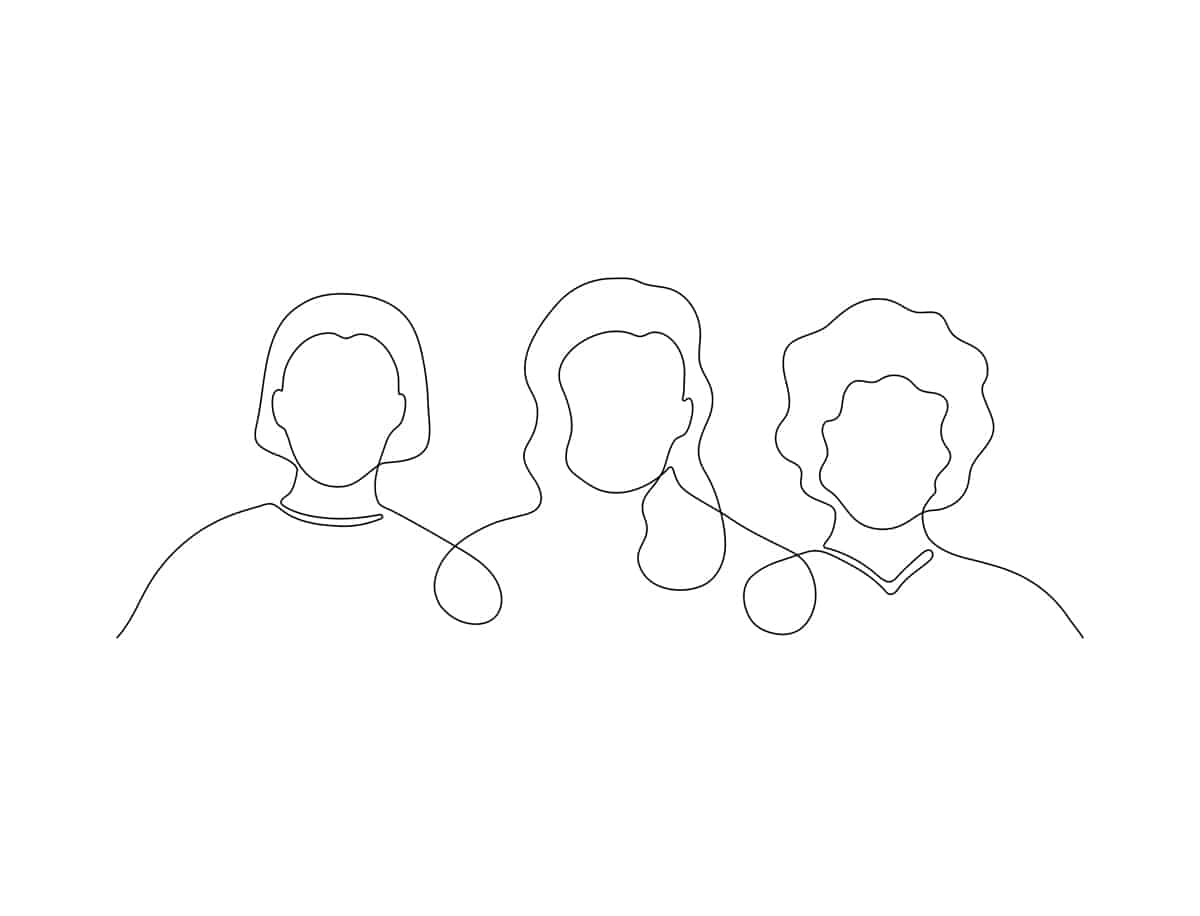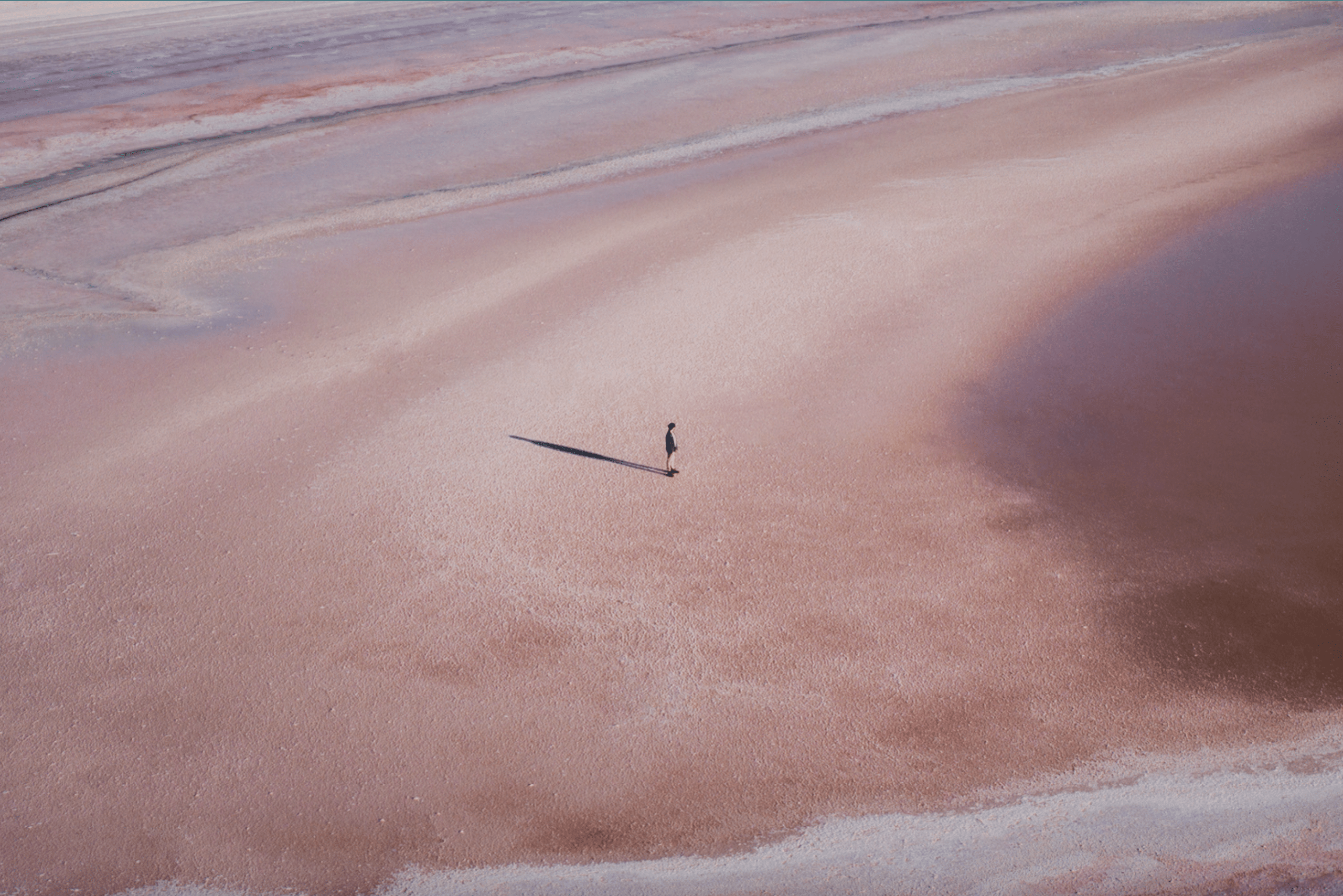When you’re just starting your professional career, finding a pricing structure that helps you land clients while meeting your financial goals can be challenging. The basic, Dickensian formula for success is to have more money coming in than going out.
In the long term, to build a thriving photography practice and support yourself, you need to devise a pricing strategy that fully accounts for your expenses and profit targets. This guide will help you do just that.
The Cost-plus Pricing Formula
Setting a sustainable price for your services begins with understanding your costs. The cost-plus pricing model is designed to help you account for all of the expenses you incur to deliver your services so you can determine exactly how much to charge to make your target profit.
Here’s an example of a cost-plus pricing calculation:
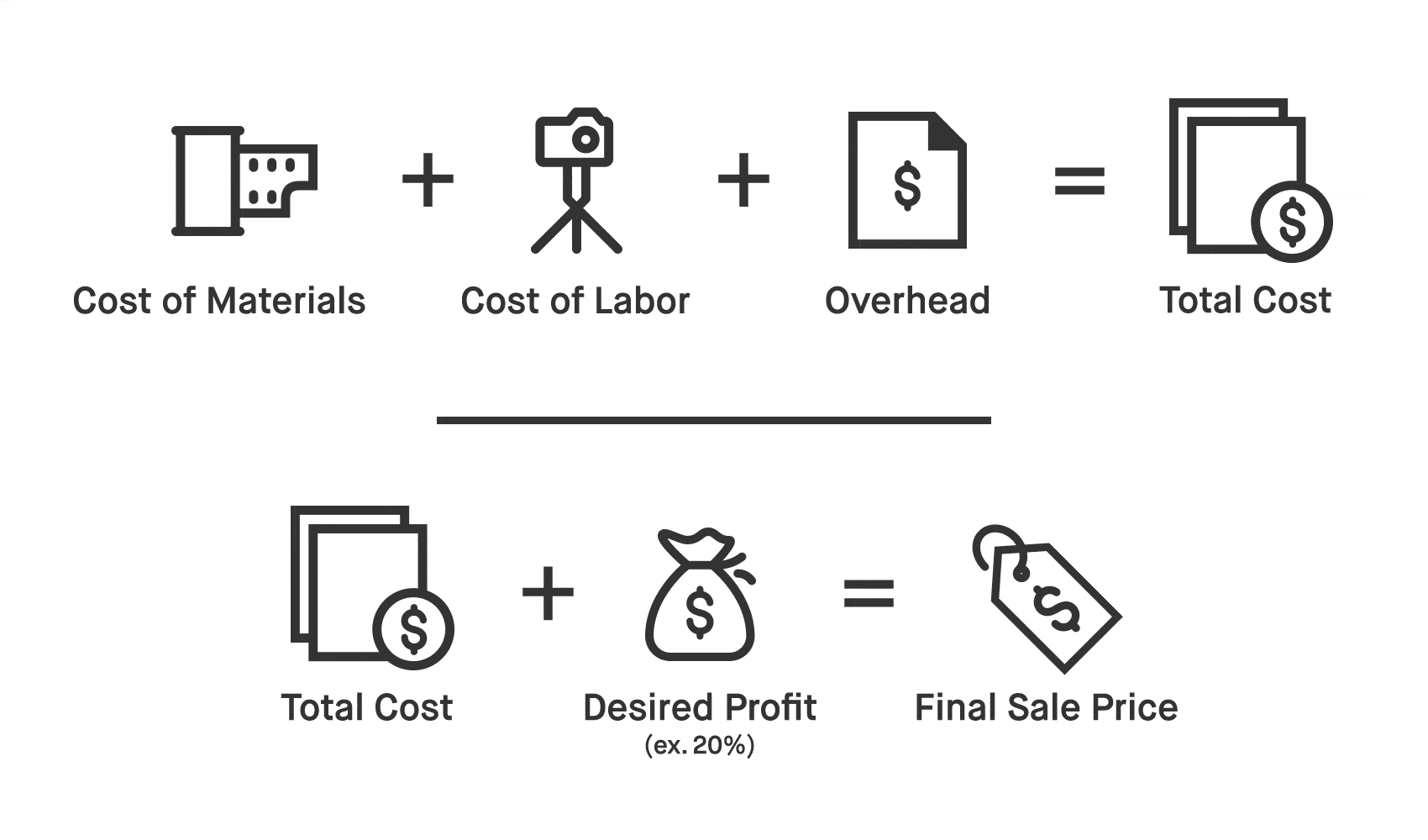
This calculation has two parts because it’s important to figure out your total cost before adding a profit percentage. First, you add up all of your expenses to arrive at your total cost. Then, you add your desired profit margin to determine your final sale price.
This is where many photographers go awry: without a clear understanding of how much it costs to stay in business, you run the risk of under-charging and making far less profit than planned. In the next section, we’ll dive into all of your potential costs in detail.
Understanding Your Costs
It’s not uncommon for new photographers to feel uncomfortable setting a high price for their service. For example, if your fee works out to a far higher hourly rate than you might receive in a salaried job, you might feel you’re overcharging your client.
But the reality of operating your own business is more complex, with many hidden costs beyond just your hourly rate for delivering a service. Let’s take a look at the different elements you should factor into your cost-plus calculation: the cost of materials, labor, and overhead, as well as fixed and variable expenses.
Cost of Materials
Your cost of materials should include all the tools and accessories you need to purchase to deliver your services.
This includes your investment in:
- Professional cameras
- Lenses
- Tripods
- Lighting gear
- Props
- Backdrops
- Computer (laptop or desktop) for processing your files
- Hard drives for archiving your work
- Memory cards
- Other miscellaneous equipment like spare batteries and your phone
As photographers know well, these tools can wear out or become obsolete, requiring expensive upgrades or replacements to maintain the quality of your services. That’s why it’s critical to incorporate a fraction of these costs into each client invoice.
On top of photography equipment, you may also have to take on the cost of printing images or photo books and shipping them to your clients as your final deliverable.
Each of these materials and services you provide directly impacts your ability to perform and deliver professional results, making them reasonable expenses to build into your pricing strategy.
Build Your Portfolio With Format
Rated #1 online portfolio builder by photographers.
Selling Digitally
One way to cut down on material expenses related to delivering images is to focus on selling digitally. There are still costs associated with managing your digital files, but they’re considerably lower than printing, packaging, and shipping physical prints.
Using Format, you can set up an online store as part of your portfolio. This gives you a single place you can direct potential clients to where they can see your work and easily purchase prints. Using this approach, there are no extra expenses to include in your cost-plus pricing model because the option to set up an online store is already included in every Format plan. This allows you to streamline your business and save considerable time on logistics.
Compared to using an online marketplace, setting up your own digital shop gives you complete freedom over how your images are displayed, and you don’t have to worry about them appearing next to images from competitors.
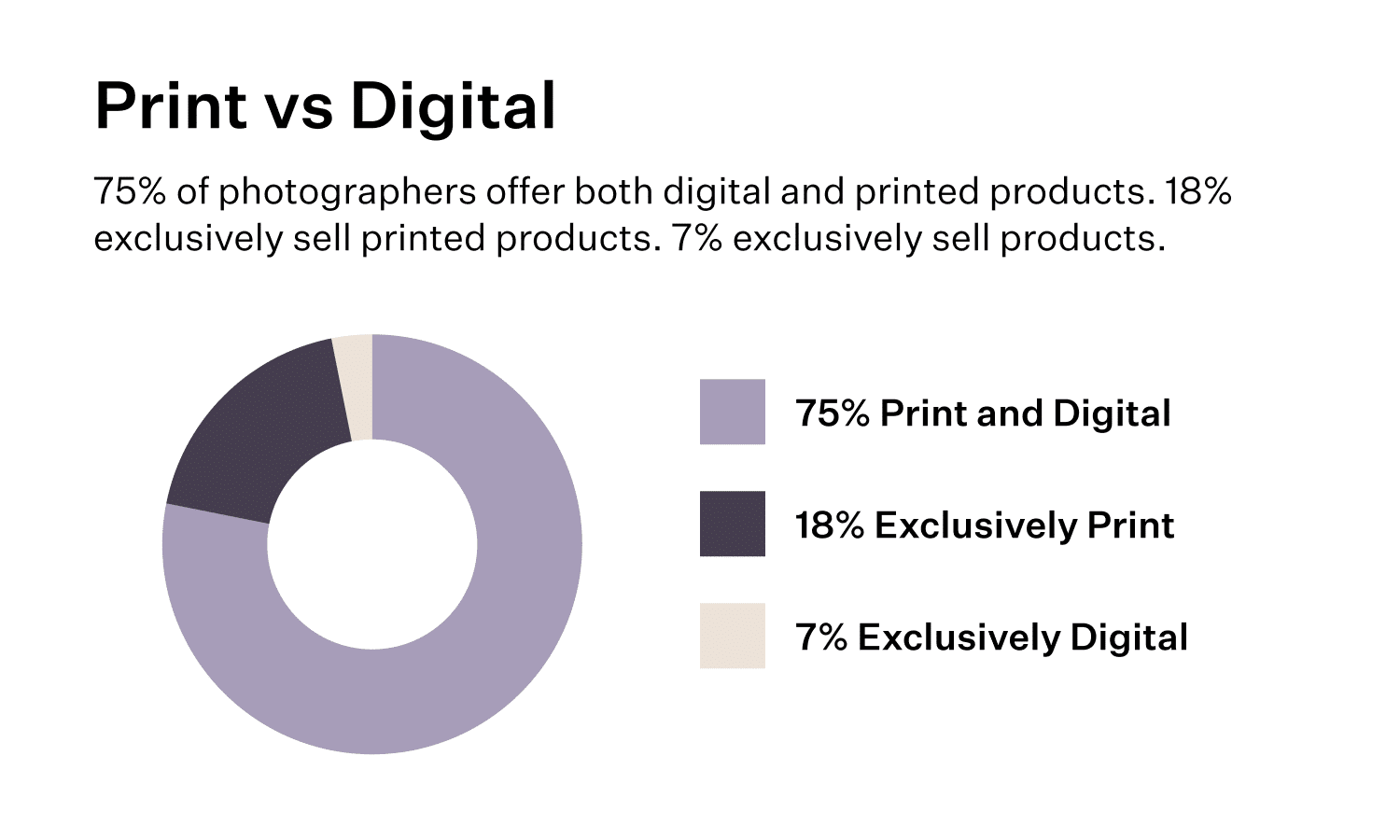
Cost of Labor
At first, the cost of labor might appear to simply be the time spent planning, on set and in post-production. But in reality, labor costs in your business likely extend beyond your own pay as the primary photographer.
Your expertise and time are central to your service, but additional labor may be required to deliver a smooth experience from planning through shoot day to delivery. Make sure you account for all of this in your pricing and invoices. Here are some examples of additional labor costs you might incur by hiring professionals to outsource some of the work:
- Assistant photographers to help during larger or more complex shoots, or for large events such as weddings
- Professional photo/video editors to support post-processing work if your schedule becomes too busy to handle it yourself
- Virtual assistant to help you manage bookings, customer inquiries, social media, or other administrative requirements
Recognizing this full spectrum of labor costs will help you accurately price your services.
Finally, answer this question honestly: How much is your time worth? The more experience you have, the greater your value, and the more your labor should cost. This means that your fee calculation should be assessed periodically to make sure you’re paying yourself enough.
Freelance Photographer Tip: It can feel great to get lots of jobs, but be wary of small gigs that chew up time with low profit. Instead, focus on booking fewer, bigger jobs. One big job can be worth several smaller ones (and save you from burning out!)
Overhead Costs
Overhead costs are the ongoing expenses–not tied to any specific project–required to run your photography business. For example; a one-day studio rental for a shoot wouldn’t be an overhead cost, but renting your own studio on a monthly or annual basis for operating your business is one.
Examples of overhead costs include:
- Monthly rent if you choose to rent an office or studio space
- Utilities associated with your business; even if you work from home, you’ll need to pay for utilities like internet and a phone plan to run your business
- Insurance to cover liability and protect your equipment and studio
- Professional services, like accounting and legal fees
- Marketing and advertising expenses, including maintaining a portfolio website, running ads, and creating promotional materials
- Software subscriptions and professional membership dues
To account for overhead costs in your pricing structure, start by adding up your expenses for the year. Now, divide your total by the projected number of jobs you’ll likely work in a year. Add that sum to your fee quote for each gig to ensure every job contributes to your overheard.
For example, let’s say your overhead will be roughly $12,000/ year, and you anticipate working roughly 2 paid jobs per month, or 24 over the course of the year. Adding $500 to the price of each job will cover your overhead by the end of the year.
Freelance Photographer Tip: When you’re just starting out, an effective way to offer affordable prices is to lower your overhead costs. Decide what’s necessary to do a good job and stick to the basics.
So far, we’ve covered your material, labor, and overhead costs. This accounts for expenses that go into delivering your services, but there’s one more important concept to familiarize yourself with if you want to confidently make a profit on every job: fixed and variable expenses. Let’s take a closer look at each of these.
Fixed Expenses
Fixed expenses remain constant regardless of the number of projects you book. These include:
- Equipment depreciation
- Regular loan payments
- Salaries for permanent employees, including yourself even if you are a one-person business
By including fixed expenses in your cost calculations, you ensure that your pricing covers all aspects of your business operations, not just the direct costs associated with each project. This is key to making a profit instead of just breaking even.
Variable Expenses
Variable expenses fluctuate based on the specifics of each project.
For example, wedding photographers often incur travel expenses like transportation, accommodation, and meals. Event-specific props, equipment rentals, hiring needs, location fees, and other special requests from clients can add to the variable expenses of a project.
Accurately accounting for these variable expenses in your pricing ensures that each project remains profitable, and makes it clear that fixed-rate fees usually aren’t practical for photographers since costs can vary considerably from one job to the next.
Our Photography Pricing Guide to Success
Once you’ve calculated your material, labor, and overhead costs, you can determine your pricing for each project.
Start by adding a profit margin to your total cost to arrive at your minimum fee for a given project. A realistic profit margin will depend on factors like the quality of your work, how you’re perceived in the market, and your experience. If your jobs tend to have a similar structure, you should be able to come up with starting prices per session based on the number of hours and equipment required, and once you have invoices for a few different types of work, you can use these as a template going forward.
From here, you can create packages as a baseline, but it’s always wise to maintain flexibility to accommodate client needs and varying project scopes.
We’ll take a look at an example.
Let’s say you have a portrait photography session and have calculated the following costs:
- Material costs: $500 for camera, lens depreciation, and lighting gear usage, calculated based on the cost of each equipment item divided by the number of shoots it is likely to be usable for before requiring replacement
- Labor Costs: $400 for your time and $200 for an assistant photographer
- Fixed and overhead costs: $600 for studio rent and a portion of fixed expenses like software, insurance, and utilities
The total cost for this session is $1700. Adding a 30% profit margin, the calculation would be:
Total Cost = $1700
Profit Margin = 30% of $1700 = $510
Minimum Fee = $1700 + $510 = $2210
This approach ensures that your pricing covers all expenses, compensates you fairly, and includes a profit margin that reflects the value of your work and enables you to invest in and grow your business.
Freelance Photographer Tip: To demonstrate that you are an active photographer and drive your business, update your online portfolio frequently with current projects, and make the most of SEO.
Industry-Specific Pricing Considerations
Commercial Photography Pricing
Commercial projects can come with a wide range of unique client needs and specific project costs. For this reason, commercial shoot rates can vary widely: it’s not uncommon for them to run from $20,000 to $85,000 or more, reflecting the project-specific expenses and expertise of the photographer.
Consider consulting with local commercial photographers to understand market rates, since these can vary depending on your geographic location and industry.
Event Photography Pricing
Event photography rates are often based on event size, location, and photographer experience. However, a typical range for rates is between $200 and $500 per hour.
Larger events often require multiple photographers and additional equipment, which can add to your expenses.
Portrait Photography Pricing
Portrait photography packages generally start between $150 and $300, depending on your location and the type of portraiture you offer.
Many photographers choose to offer industry-specific deals for corporate, family, or school portraits to attract a larger portfolio of clients. Creating different pricing packages for these client types can help you boost client acquisition and book larger projects, where the profit margin may be slightly lower but the volume of work justifies offering a deal.
Graduation Shoot Prices
A typical range for graduation picture packages in North America is between $100 to $400 per session. Packages often include a graduation gown, cap, tassel, online proofs, and digital images. Higher-tier packages may offer additional locations and more photo options.
To set competitive rates, it’s a good idea to consult with schools about their past expenditures and align your pricing with their expectations–and your interests–while staying competitive, as these connections can mean repeat business year over year.
Wedding Photography Prices
The average cost of wedding photography in the United States is around $2,000, but prices have to take into account factors like event length, guest count, and geographic location (WeddingWire).
Wedding packages often cover anywhere from four hours to unlimited coverage and may include pre-wedding planning meetings, prints, equipment costs, and/or additional staff like a second photographer or a videographer.
Thousands of customizations to match your unique style.
Customize your site to tell the story of your brand. Format has nearly 100 templates offering thousands of design variables.
Different Approaches to Building a Pricing Model
The cost-plus pricing model is a great place to start and can help you gauge your minimum pricing, but there’s also a value-based approach—which we’ll dive into next—that can help you determine prices which are truly reflective of the value of your work.
Rates Based on Price Per Photography Use
Usage-based pricing is ideal for projects where the images will be used in high-profile, profit-generating applications, like product photography.
This model factors in how, where, and how often the photos will be used. For example, photos used in a national campaign can command higher rates than those in a local newspaper.
Additionally, the duration of usage (ie. one-time use vs. repeated use) impacts pricing. The Association of Photographers offers an image usage calculator to help determine appropriate rates based on licensing period, media type, and usage territory.
Hourly Rates
Charging an hourly fee is standard for event photography, like weddings and corporate events. This ensures you get paid for all the time invested, including potential overtime.
Research average hourly rates in your area to remain competitive, but make sure your hourly fee accounts for pre- and post-event activities, like travel, client meetings, preparation, and post-production.
Flat Rates
Experienced photographers sometimes opt to charge flat rates for projects, which requires a deep understanding of the work and costs involved in delivering their services. If you opt for this approach, be sure to familiarize yourself with local rates to ensure your prices are in a reasonable range.
Another important consideration with a flat rate model: since you won’t be paid extra if the job goes longer or becomes more complex than initially planned, it’s extremely important to create a contract that outlines the scope of work and allows for additional charges if the project extends beyond the agreed-upon scope. This can include specifications around the number of images, feedback rounds, retouching, and additional services.
Rates Based on Experience
Experience can significantly influence photography rates. While there is no one-size-fits-all price range, these figures should give you an idea of rough industry expectations by experience level:
- Beginners: $25-$75 per hour
- Students: $50-$100 per hour; depending on training and experience
- Entry-level: $50-$150 per hour; recently trained with limited experience.
- Professional: $75-$250 per hour; expected to have comprehensive skills and deliver high-quality work
- Top photographers: $250-$500 per hour or up to $10,000 per day for high-end projects
Rates Based on Specialty
Specializing in a specific type of photography can enable you to charge higher rates.
While new photographers may fear they’ll miss out on opportunities if they specialize narrowly, expertise in areas like documentary, portrait, sports, product, fashion, or wedding photography often commands higher fees.
Some areas of specialization can command higher fees than others. For example, since wedding photographers need to produce great work in a stressful, high-stakes environment, they tend to be paid more than portrait photographers.
Another important factor to consider is how work will vary in your chosen speciality. Sticking with our example of wedding photography, its seasonal nature and the bulk of business coming in the same quarter also means that the rates per project tend to be higher.
How to Test Your Photography Pricing Model
Determining the right pricing for your photography services is an ongoing process; the prices you settle on today won’t necessarily always be ideal for your business–we haven’t even touched on inflation!
So here are some practical steps to evaluate and adjust your photography pricing model:
- Gather customer feedback: Ask for direct feedback on whether the pricing matched the value received. These insights can highlight areas where you might be undercharging or overcharging.
- Monitor your booking patterns: A high booking rate beyond what you can accommodate comfortably might indicate that your prices are too low, while a low rate could suggest they are too high. Adjust accordingly to find the sweet spot.
- Analyze your margins: Regularly review your profit margins. If you notice your margins shrinking, it may be time to reassess your rates.
- Experiment with different models: For instance, you could test hourly rates against flat rates or introduce package deals to see what resonates best with your clients.
- Adjust for seasonality: Some photography services have seasonal demand, and it’s completely acceptable to have peak and off-peak pricing.
Get the Low-Down on your Competitors
To understand your market better, analyze other photographers in your area. Conduct market research within your niche to compare your pricing model with that of your competitors. Clients will be doing the same thing, so it’s important to know where you sit in the larger industry.
When reviewing competitor pricing, keep the following considerations in mind:
- Do they favor à la carte solutions, custom packages, or add-on options?
- What are their rates compared to yours, and what pricing model are they using?
- Where are they located—is it possible they’re in a different region with different costs?
- How do they communicate their value—for example, does the style of their online portfolio make them appear particularly high-end?
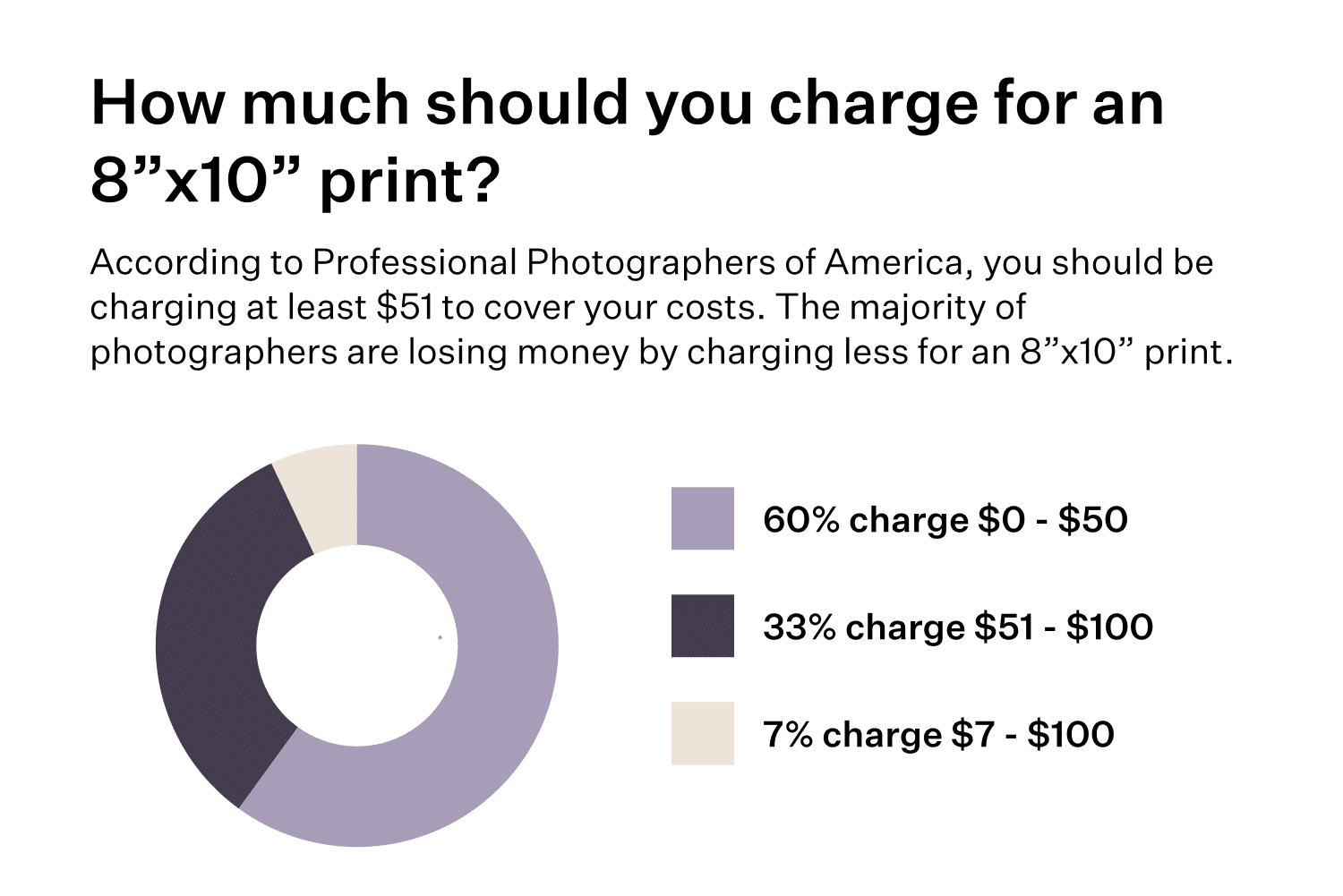
Don’t feel obligated to match your competition’s prices exactly. Use this exercise to get an accurate picture of industry expectations in your niche and geographic area, but don’t devalue your experience, talent, and soft skills. If you believe your services are worth more, set your prices accordingly.
In some cases, competitors’ models represent best practices, offering guidance on how to structure your pricing. In others, you may find opportunities to innovate and disrupt the market.
While pricing your work can feel overwhelming, this guidance will give you not only a starting point, but a way to check back in with your business. If anything, keep this simple rule in mind: be realistic, but never undervalue yourself.









